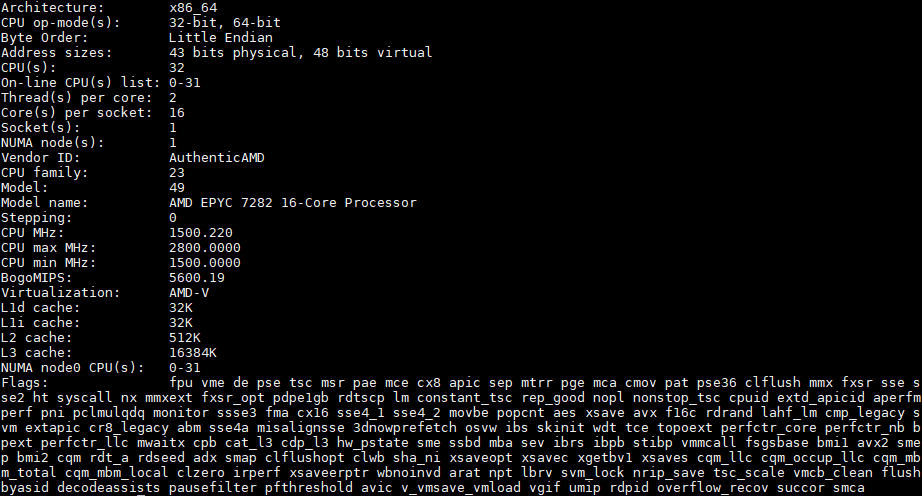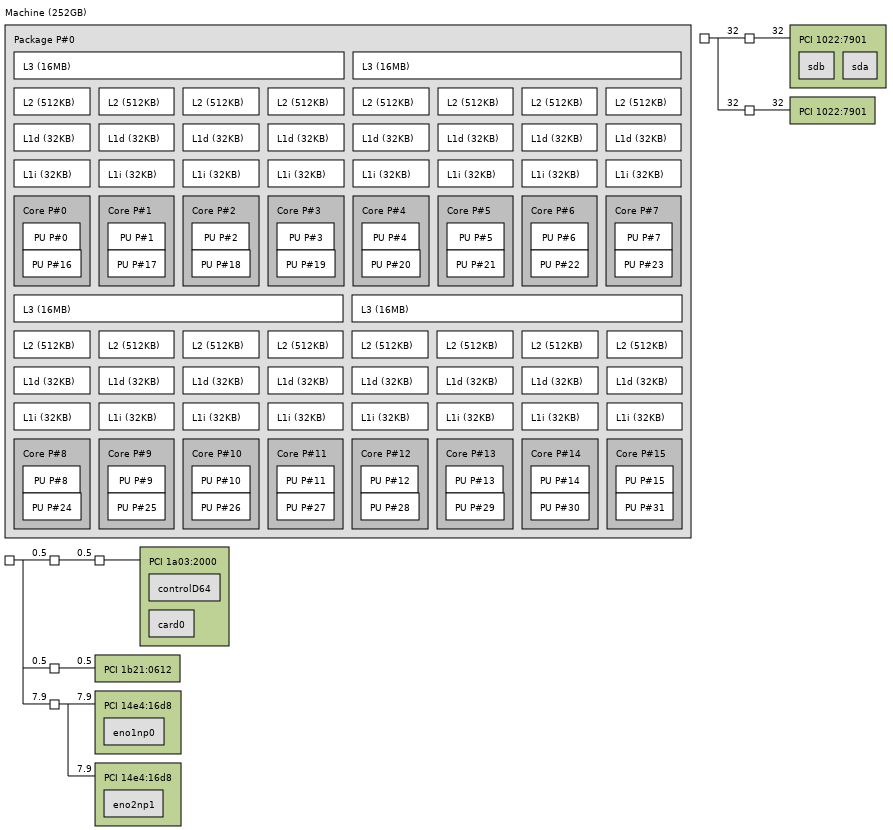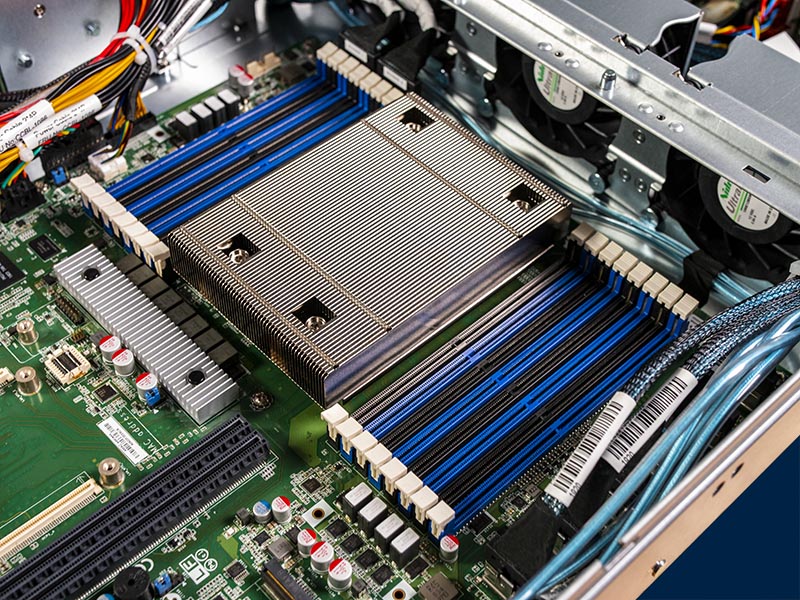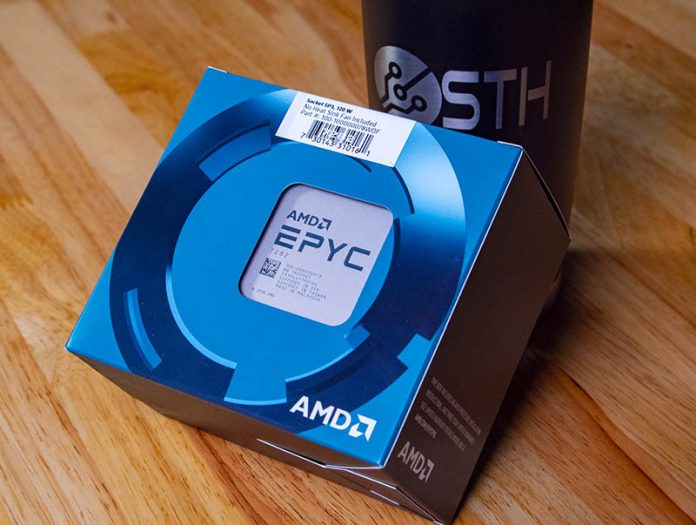The AMD EPYC 7282 is a processor filled with mystique in some circles. It weighs in with a scant 120W TDP yet it has full PCIe Gen4 I/O, memory capacity, and sixteen cores. If you were looking for a lower-power AMD EPYC 7002 series CPU, this is it. In fact, Patrick mentioned it in his AMD EPYC 7002 Rome v Threadripper for Workstations piece because many stop by STH and openly wonder if it can even handle workstation roles as a $650 16-core part. In our review, we are going to see how well this part performs.
Key stats for the AMD EPYC 7282: 16 cores / 32 threads with a 2.8GHz base clock and 3.2GHz turbo boost. There is 64MB of onboard L3 cache. The CPU features a 120W TDP. These are $650 list price parts.
Here is what the lscpu output looks like for an AMD EPYC 7282:

Unlike the previous generation AMD EPYC 7001 series parts, such as the AMD EPYC 7301 this is a “Rome” part that has all 16 cores on a single NUMA node. You can see this in action in the following topology diagram:

For a 16 core CPU, this is a much-preferred topology to four NUMA nodes in most cases. That is a big generational improvement. We see that the system’s peripherals all are attached to that single I/O die.
Something important with the AMD EPYC 7282 is that this is considered a 4-channel optimized part due to the die configuration. We went into detail about what that means in our piece AMD EPYC 7002 Rome CPUs with Half Memory Bandwidth piece and we have a short video on it here if you want to listen while reading this review:
The AMD EPYC 7282 has another distinction. It is the lowest cost 16 core CPU that one can put in a dual-socket AMD EPYC 7002 series server. That plus the lower TDP makes it a different value proposition than much of the rest of the lineup. If one needs an acceptable amount of CPU performance, but instead is more focused on enabling I/O, this type of solution will appeal to many buyers. At only $650 and with a lower TDP, it is a hard option to ignore.
Test Configuration
For most of our charts, we are using the Tyan Transport SX TS65A-B8036.
- Platform: Tyan Transport SX TS65A-B8036
- CPU: AMD EPYC 7282
- RAM: 8x 32GB Micron DDR4-3200 RDIMMs
- OS SSD: 400GB Intel DC S3700
- Data SSD: 960GB Intel Optane 905P
You are going to see more about this platform, but this is a PCIe Gen4 single-socket platform from Tyan that has 16x front U.2 NVMe bays, 10x front SATA/ SAS bays, two rear 2.5″ SATA OS SSD bays, six expansion slots on risers and an OCP mezzanine slot. All this is achieved using a single AMD EPYC 7002 series CPU.

If you count the PCIe lanes and bandwidth in the platform, Tyan is offering more PCIe I/O than a dual-socket Xeon server in a single socket AMD EPYC 7002 server. This lower-cost CPU is able to power this enormous platform.
Also, one may read that you cannot use Optane with AMD EPYC. While it is true that you cannot use the Intel Optane DCPMMs with AMD EPYC, you can use their standard NVMe form factor. Intel Optane NVMe SSDs are excellent for database applications as an example when paired with EPYC.
A Word on Power Consumption
We tested these in a number of configurations. Here is what we found using the AMD EPYC 7282 in this configuration when we pushed the sliders all the way to performance mode:
- Idle Power (Performance Mode): 113W
- STH 70% Load: 224W
- STH 100% Load: 262W
- Maximum Observed Power (Performance Mode): 319W
This is not an enormous power burden on a rack even with 16 cores. In many systems built around these CPUs, the peripherals such as SSDs, accelerators, and NICs will use more power than the CPUs. We were hoping for better figures given the AMD EPYC 7302P is not 35W higher power at the top end. Still, this is a very reasonable power consumption figure.
Next, let us look at our performance benchmarks before getting to market positioning and our final words.





It’d be very nice to have some Threadrippers in the charts…
Hello,
i am a bit confused about the power consumption of the 7282 vs 7302p. Why is the 7302p so much better then the lower TDP 7282? I would have expected it the other way arround.
regards
John, you mention “This is not an enormous power burden on a rack even with 16 cores. In many systems built around these CPUs, the peripherals such as SSDs, accelerators, and NICs will use more power than the CPUs. ” on first page, but it would be good if you include “fans” there too. For example I see this tyan is using 2 fans. If those are like in my tyan, then they are screamers and every consume >55W which means just 3 fans have higher power consumption than the CPU itself.
So telling power consumption of whole box is nearly meaningless number if you do not mention precisely what components and with what power consumption exactly where inside the box.
Otherwise nice article!
The power consumption benchmark seems to be off, it doesn’t make sense that it would be higher than the 7302P, and others have reported much lower values. See here: https://forums.servethehome.com/index.php?threads/power-usage-of-amd-epyc-7282-vs-7302p.32478
Come fast reply